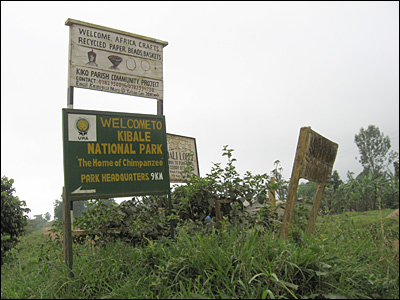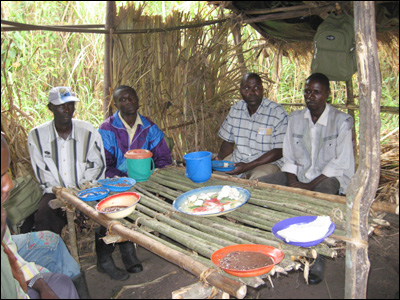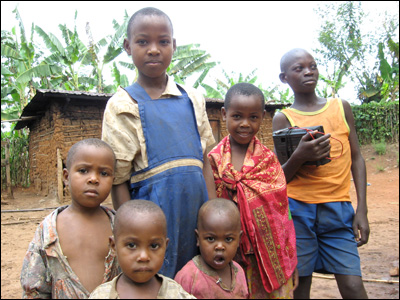|
Reporter's Notebook: On the Carbon Trail
By Anna Sussman

Entrance to the Kibale National Park in Uganda.
Photo by Anna Sussman
The road is muddy and the forest is thick as we drive through Kibale National Park in south-western Uganda. Families of hungry baboons forage on the roadside.
To get here, my partner and I, both American journalists living in Uganda, drive five hours over rough, pot-holed roads from the capital, Kampala. We come here not just to admire the flourishing wildlife, though that's an important part of our investigation. But we're also here to examine Kibale's curious role in the booming global carbon market.
As industrialized countries grapple with global warming, buying "carbon offsets" is becoming a popular way to try to neutralize carbon emissions. The idea is tantalizingly simple: a company or individual can compensate for CO2 emissions by purchasing "credits" from projects that pull greenhouse gases out of the atmosphere. Tree planting is an example. In the mid-1990s, a Dutch group called the Face Foundation contracted with the Uganda Wildlife Authority to plant some 80,000 acres of trees in two locations, Kibale and Mount Elgon National Park in eastern Uganda. The Face Foundation generates carbon credits based on the estimated amount of CO2 each tree pulls from the air. The foundation then sells those credits to Western companies looking to offset their carbon emissions. One of Face's customers is Tendris, a company that markets a "green" credit card.
This elaborate global scheme has the potential to create a number of benefits: trees are planted, jobs are created in Uganda, and families and businesses in Europe and the United States can reduce their "carbon footprint." But carbon trading has its share of problems - its science is questionable, and many criticize the carbon market as a quick fix to a complicated social problem.
At Kibale, the land is the first thing we notice. Areas where trees have not been planted are lifeless. We see no animals and there is little fauna, only stubborn elephant grass that is inhospitable to wildlife and prone to devastating wildfires. However, the land that has been reforested teems with wild birds and monkeys.
High on a hillside of the lush Rwenzori Mountains, park rangers show us which land has been re-forested and which patches await help. The contrast is sharp; lush deep shades of green versus a sickly pale yellow.

Local men hired to plant trees pause for a lunch of boiled beans and mashed plantains.
Photo by Anna Sussman
At a planting site, 300 local men hired by the Face Foundation have lunch under a shelter with a thatched roof. They eat boiled beans and mashed plantains. The workers wear gumboots and carry machetes. They don't seem to mind the light rain. The men spend their days slashing elephant grass, ferrying saplings on their backs, digging holes and gently patting the soil around new trees.
When we talk, the workers easily recite the benefits of re-forestation. One planter tells us, "We need this forest. It is this forest that helps us get rainfall, so we are able to get water. Also it is a job opportunity. The income helps my family."
But when the park rangers are out of earshot, workers complain that pay is insufficient. They say a dollar a day is not enough to pay school fees for their children, or cover the costs of their meager material needs - pots and pans, clothing and plastic tarps.
Some of these workers used to live in Rwenzori Mountains National Park. They say their families were burned out of their houses by the police to make way for the reforestation project.
The Ugandan Wildlife Authority says the families were living on the land illegally. It insists the evictions were unrelated to the tree planting project. And the men get free medical care, a job benefit unheard of elsewhere in Uganda.
Wilson Turinawe, a farmer, says his family moved into the park during the tyrannical rule of Idi Amin, when the government opened up the park for settlers. Turinawe says he had a house and farm in the park, where he grew maize, beans and bananas. But after Amin's ouster, the government's attitude towards the settlers grew hostile.
"We were given one month's eviction notice. It was quite a shock having lived in that land over 20 years," he recalls. "They burned down all the houses. There was no house that was left standing. I watched my house burn. They came with guns. They beat me up. Some people died during the evictions."
Turinawe now lives in a small mud home on the park's outskirts with his wife and eight children. His says the land outside the park is so densely populated there's little remaining acreage for farming.

Wilson Turinawe's children
Photo by Anna Sussman
As we talk, Turinawe's children gather around the low entrance to the hut. They are curious, and jostle for a view of our interview. Their clothes are thin and ripped. Some of the kids are pale and seem to be malnourished.
This is where the carbon trading scheme starts to feel uncomfortable: in the stark contrast between Turinawe's family and the comfortable lives of families in the United States and Europe who finance the tree planting in the name of saving the planet. I imagine a dinner table scene in the Netherlands, where a happy family enjoys moral reprieve from a credit card statement announcing that the month's food and gas purchases are "carbon neutral," thanks to tree planting in Uganda.
There is something unjust about the equation here. The environmental woes of Western over-consumption are being conveniently cleansed thousands of miles away in a remote Ugandan park, and neatly packaged and sold as carbon neutrality to well-meaning consumers. Meanwhile, villagers in Africa are left displaced, underpaid and hungry. This scenario feels familiar: Western companies and consumers building complex trading markets on the backs of people in the developing world, all in the name of saving the planet.
But what we hear next surprises us. Most villagers say that despite low wages and disappearing land, despite brutal evictions and reduced access to forest resources like firewood and herbs, the tree planting project is worth it, if just for the work it provides.
We meet a village elder sweeping piles of dirt outside his home. He tells us how he watched screaming villagers flee their burning homes during the evictions. But he tells us that in the end, the Face Foundation has done well by his community. "The Face project, in my opinion, is very good. The next generation here, they are getting employment, they are getting money they need."
We say goodbye to the village. But on our way back to Kampala, we encounter an urgent carbon problem of our own. Uganda is in the midst of a fuel shortage, and there is no gas to be found for our SUV. After some searching and a little bargaining, we are on our way.
Back in Kampala, we meet activist Timothy Byakola. He is fighting the mistreatment of villagers in the areas being reforested by Western carbon brokers. He says people are regularly beaten for sneaking into tree planting areas to plant crops.
We ask him what should be done to offset carbon emissions, if not tree planting. What Byakola says seems to make a lot of sense. "The carbon should just be kept where it is in the first place."
| 
